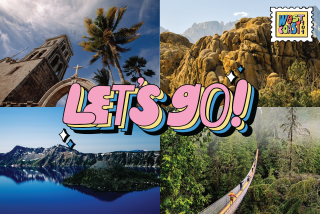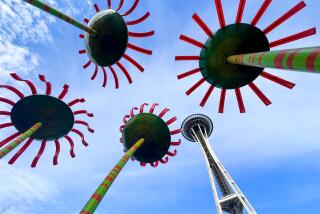Residents Worry About Buildup of Real Grunge : City is proud of its position as a trendsetter in music, fashion and other fields. But urban problems mar the image.
- Share via
Seattle knows of fateful extremes. Back in its early days, lumbermen dragged logs down muddy, truculent Yesler Way and gave America a name for such streets: Skid Road. But in its recent glory, the self-styled Emerald City, birthplace (so it claims) of the happy-face logo, the water ski, the revolving restaurant and the down parka, climbed to the top of just about everyone’s list of most livable cities.
In between have been loopy ups and downs, from the gilded launch of the Klondike gold rush in the 1890s to the great collapse of Boeing in the 1970s.
Now Seattle finds itself in the curious circumstance of heading up and down at the same time--enough to make the damp, stolid denizens a little dizzy. And disquieted.
If you’re wired into pop culture, you know, of course, that Seattle is a trendsetter in rock music, strong coffee, handmade beer, fresh fish, he-man football, grunge fashion and eco-culture. The city couldn’t be prouder of itself, reading its own press clippings. Think of it, the world taking its cue from us .
Local residents, whose endearing trait is the belief that their civic destiny remains wholly within their control, are dreaming big about the future, too.
Popular Mayor Norm Rice is pushing an ambitious, some say visionary, plan to absorb population growth by creating networks of 21st-Century urban villages scattered around the cityscape. These self-contained neighborhoods would favor foot traffic and connect with public transit.
But Seattle has more weighing on its mind these days than lively image and grand dreams.
Like drugs, panhandlers, gangs, crime, recession, congestion, sprawl. And maybe worst of all, fear of losing grasp of its fate.
In the past, these unpleasant realities were voiced, if at all, in a civic whisper and with a cheerful certainty that things were worse elsewhere. But the whispers have become full-throated cries, and elsewhere isn’t looking so bad.
Consider this Rotary Club speech from City Atty. Mark Sidran: “We Seattlites have this anxiety, this nagging suspicion that despite the mountains and the (Puget) Sound and smugness about all our advantages, maybe, just maybe, we are pretty much like those other big American cities back East, as we used to say when I was a kid, before California joined the list of ‘formerly great places to live.’ ”
Or this from resident Kerry L. Nicholson, in a letter to the Seattle Times: “Last week, I had the good fortune of being in Minneapolis . . . . I found myself marveling at the clean streets and the almost total absence of panhandlers, drug dealers, drunks and toughs that have come to populate our downtown. What a pleasure to stand in an urban park at night and watch the fountain and not my back!”
Some of the reasons for concern:
In the few blocks between the retail core of the city and the popular Pike Place Public Market is a knot of illicit drug activity, including a city-sanctioned sidewalk needle-exchange for addicts. The parks, particularly around the Pioneer Square tourist attractions, are crowded with derelicts and the homeless. Panhandlers sometimes number a half-dozen to the block.
Two major department stores have closed and remain empty. Critical local industries, Boeing and lumber, are on hard times. The University of Washington’s highly rated Husky football program is on probation after a sobering ethics scandal. The Japanese bought Seattle’s baseball club.
And Seattle remains the only urban center on the West Coast that has not broken ground on a rail transit system. Traffic congestion makes travel the kind of chore that shocks newcomers.
And two California-style anti-government tax revolt initiatives have made their way to the November ballot.
In the end, whether visitor or resident, measuring the bad against the good raises that question: Compared to what? One cannot easily dismiss a city’s mystique and fashion, and there’s no denying that hope still walks with bouncy strides on many streets here.
But after years of being envied, Seattle is finding nothing so strange as its own creeping envy about other places and other times.






